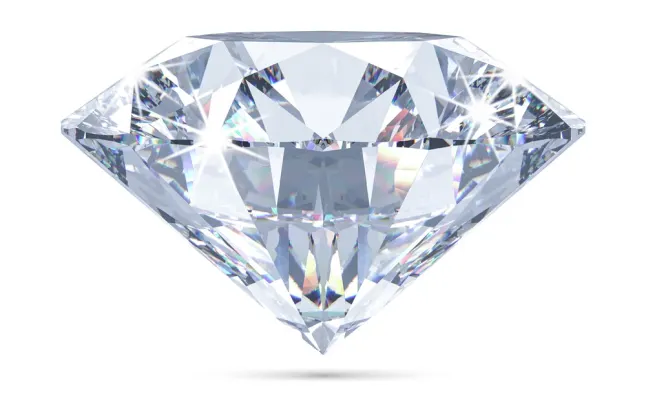Moissanite vs Diamond | Key Differences & Pros & Cons
I love to laugh and listen to good clean comedians. I especially enjoy those who do impressions of famous people. There is something special when one human can duplicate the voice and mannerisms of someone else. Sometimes, a real good impressionist is hard to separate from the person they are imitating. Oscar Wilde said — 'Imitation is the sincerest form of flattery that mediocrity can pay to greatness.'

There is something awe-inspiring about a diamond extracted from a piece of rough and then expertly cut and polished. The process of creating a gem quality diamond is laborious and expensive. It is no accident that a diamond, like a person, can be impersonated/imitated. In the world of diamonds, imitation maybe flattering. But to an untrained eye, being fooled by an imitation can be a costly mistake. So, let's dive deeper into moissanite vs diamond and discover whether it can truly outshine a real diamond!
Famous Diamond Imitators
• Synthetic. A synthetic is not really an imitation because it possesses the same chemical and crystal structure as a natural diamond. The difference is it is created in a laboratory. The challenge is identifying a synthetic from a natural one. They both test diamond with a diamond tester (because they are) and have the same refractive index (the amount light bends inside the diamond). Even a trained gemologist has a difficult time distinguishing the difference. It requires sophisticated laboratory equipment to identify a synthetic diamond.
• Cubic Zirconia (CZ). This is the most common and inexpensive diamond imitation and is made of zirconium dioxide.
• Zircon. Sometimes confused with a CZ is a natural occurring mineral and comes in many colors including white.
• Spinel. Like the zircon, it is a mineral found in many colors including white.
• White Sapphire. Is a natural gem and part of the corundum family which includes ruby. Sapphires come in many colors and are a 9 on the Mohs hardness scale. A white sapphire is inexpensive and makes a good choice for a diamond imitation.
• Glass. Very common in costume jewelry. It is easily detectable and does not have the brilliance of the natural imitations.
• Moissanite. Made of a rare mineral (silicon carbide). Most Moissanite stones are synthetic. They are doubly refractive (diamonds are singularly refractive) and display more sparkle and spectral color than a diamond. The are a 9.5 on the Mohs hardest scale and is quickly becoming the most popular diamond imitation. Let’s examine how Moissanite stacks up against the real thing (pros & cons).
Pros
The Appearance Test
One of the most obvious reasons for people gravitating to Moissanite is its brilliance and fire. Because of its chemical composition and double refractive crystal structure, Moissanite out preforms a natural diamond when it comes to appearance. When you look at a Moissanite, the light performance jumps out at you and smacks you in the face!
The Hardness Test
One of the reasons diamonds are sought after is because they are the hardest (10 on the Mohs hardness scale) substance on earth. The only object that can scratch a diamond is another diamond. Moissanite registers a 9.5 which is heads and shoulders above all the other diamond imitators.
The Value Test
High quality natural diamonds command very high prices especially in stones over one carat. Even synthetic diamonds are more expensive than Moissanite. So, it is no surprise that budget minded consumers are flocking to Moissanite.
The Ethical Test
Manufacturing Moissanite does not harm the environment like mining diamonds and are not used to fund illegal activities. For many people, this is primary reason they chose Moissanite over a natural diamond.
Cons
Perception
For some people, buying an imitation diamond is equivalent to committing fraud. In their mind, owning the real thing is far superior to a great imitation. They would never be caught dead with an imitation Rolex or diamond. Actually, normal everyday working people don’t care if you have a real diamond or an imitation. No one should be judged for how much they pay for something. Unfortunately, in this wacky world, some people are just plain snobs!
Value
Larger high-end diamonds (over one carat) can appreciate in value because of their rarity and cost to produce. An ideal cut one carat D flawless Moissanite costs a fraction of natural diamond with the same grade. Example, you could pay $5K-10K for a natural diamond with specs I just mentioned, but a Moissanite would be under $1K.
Utility
Diamonds come in small sizes starting at 1mm. Because of the Manufacturing process and the low profit margins, Moissanites are usually no smaller than one carat.
The King of Imitation
As of this writing, Moissanite stands as the current reigning King of imitation diamonds. Their extraordinary brilliance, explosive fire, durability and affordability make them a great alternative to a mined diamond.
We at RareCarat are committed to natural and lab grown diamonds. Our goal is to educate the consumer on the do’s and don’ts of shopping for diamonds. We also work with major site holders to offer significant discounts. However, this article was not written to persuade or dissuade the reader from purchasing an imitation diamond. We leave that decision up to you. We are just the messenger. What you do with the message is your business! Carpe diem!

